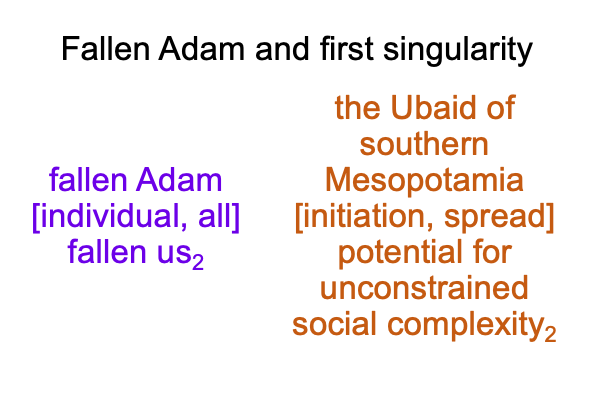0108 What is proposition 12?
Adam is created to be a priest in a sacred space. Eve is created to be Adam’s helper.
0109 Yes, Walton capitalizes on his success in applying the archetype to Melchizedek.
However, Walton is not aware of the hypothesis of the first singularity.
0110 Here is a comparison of two hylomorphes, one biblical and one scientific.

0111 This comparison turns Walton’s thesis on its head. The world of Adam and Eve is not lost. The Ubaid of southern Mesopotamia is.
Adam and Eve are memorialized as a fairy tale, placed in Scripture because it has been part of the Jewish tradition for as long as anyone can remember. Even longer!
0112 The Ubaid of southern Mesopotamia is the site where speech-alone talk unconstrains social complexity. Two hand-speech talking Neolithic cultures coalesce, driven together by the rising waters of the Persian Gulf. The result is a speech-alone talk creole, with radically different semiotic properties than hand-speech talk. It is no accident that the Sumerian language is unrelated to any family of languages.
We know that purely symbolic speech-alone talk potentiates unconstrained social complexity. Plus, we know that complexity may build or self-destruct. There is no way for us to know what really happened. We only are certain that, today, all civilizations practice speech-alone talk.
0113 Walton’s treatment of the stories of Adam and Eve suddenly have relevance, in a way hitherto unimagined.
0114 Now, I get technical.
Speech-alone talk consists of two arbitrarily related systems of differences, parole (speech act) and langue (associated mental act). We think that we can define a spoken word. We cannot. We can only project meaning, presence and message into that word. So, we project langue into parole. When we hear someone utter that parole, our projections are confirmed.
01151 What does this imply?
Each spoken word is a placeholder in a system of differences.
Spoken words can be regarded in terms of diagrammatic systems of differences, such as the Greimas square, pictured here.

0116 Walton says that Adam and Eve are “priests” in a sacred space.
So, the focal word, A, is “priest”.
The contrast word, B, is “king”.
The opposition to B and complement to A, C, must have something do to with running the garden. Yes, a priest or king could name the animals and fall in love with Eve, but what about that commandment? A priest follows God’s commandments. A king is sovereign. A king makes the rules.
So C, the contradiction to B and complement to A, is “someone who follows the rules”.
And D, the contrast to C, the opposition to A and the complement of B, is “someone who makes the rules”.
Here is a picture.

0117 Besides showing that the Greimas square is a powerful tool, the challenge posed by God’s commandment not to eat the fruit from the tree of the knowledge of good and evil becomes more palpable. Adam can be priest, but not king.
Now, Walton does not know this. Walton does not know that the hypothesis of the first singularity changes the waters below his discussion.
0118 This brings me back to Melchizedek.
In the Lebenswelt that we evolved in, hand-speech talk can not fully differentiate the roles of priest and king.
However, hand-speech can easily denote someone who is both priest and king. For example, in tribal gatherings, carrying the laurel branch may designate what we would call, both “priest” and “king”. One can picture and point to the laurel branch and the one carrying the laurel branch.
In hand-speech talk, the referent defines the gestural word (parole) and the result (langue) is an intuitive awareness of the referent’s matter and form. For the one carrying the laurel branch, what we call “priest” corresponds to esse_ce and what we call “king” corresponds to essence.
0119 In Genesis 14, Abram pays tribute to someone who transcends the differentiation of the roles of priest and king.
Here is a picture.

